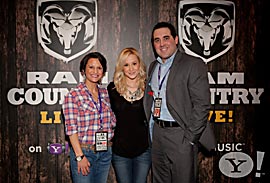
Here is part two of
Marketing Daily'sinterview with Ram truck brand’s Marissa Hunter, who heads up marketing communications for Chrysler's Ram Truck brand. She talks about how the brand is
reaching potential customers and using social media and event marketing to do it. Part
I ran on Wednesday.
Q: In terms of the truck market, how are you defining the Ram customer as distinct from other truck brands?
A: We look
at our target opportunities in a few different ways. There are definitely lifestyle categories that we want to talk to and there are vocational, work and commercial audiences we want to talk to -- and
it's fair to say most, if not all, are competing for the attention of those same people. But we have identified other audience groups we think would be interested in hearing what we want to say and we
have started talking to them as well. One of them is our heightened focus with the Hispanic audience. We have had testimonial-style custom campaigns, in language, and we also deliver those campaigns
in English-language [to Hispanic consumers].
Q: The Ram approach has always had an attitude around things like the Hemi engine, with those "That thing got a Hemi?" ads.
A: Quite frankly, our approach is not so in-your-face and aggressive any more, partly because we recognize candidly where we were a couple of years ago. To find our way out of that
situation required a lot of self-reflection and refocus internally: how were we going to build these trucks? How were we going to engineer these vehicles? How were we going to take care of our
customers? We had to eliminate the problems, eliminate the apprehensions and give them something they can believe in and trust. Then, how to convey that new approach to them through advertising and
communications: different textures, different environments, different words. For example, the involvement of [actor] Sam Elliott as the voice of our brand. All of that was important as we reshaped who
Ram was going to be.
Q: What are you doing "on the ground" to get prospective customers into Ram trucks?
A: This year we have worked very hard
to develop and implement more robust experiential events and activations because we recognize that once consumers experience the brand, their perception of the brand changes almost
immediately.
Q: What are some ride-and-drive programs you've been doing?
A: At the Chicago Auto Show, we had a Ram test-drive program we built
inside the McCormack Center. In a period of 10 or 12 days during public days, we had throughput of over 27,000 test drives there. And we talked to consumers before and after and have product
specialists who talk to them during each of the various elements of the course. We plan to execute ride-and-drive experiences at other key auto shows and consumer events this calendar year and
beyond.
Q: Are you getting your social media agency involved in these events?
A: We are. As you know, our social agency is Ignite. So we are inviting
them to more events as well. They were at Chicago on the floor of the show sharing information, tweeting and blogging information that was coming out of experiential test tracks after consumers
experienced it. What we are trying to do is capture real-time comments and images and push them out to social networks. And in the process we are inviting consumers to share with their friends, to
share with their followers.
Q: How important is the digital space for the truck market?
A: Generally, we need to be very present in the digital
space. That's where we need to build our brand, connect with customers and sell trucks. And we know there are digital elements that serve all portions of the [purchase] funnel; you can use digital to
support upper, mid and lower.
Q: What are you seeing in that space that intrigues you now?
A: One thing we are exploring is ways to create
modular online ads, where you have specific models of truck paired with specific environments, for example. Then, based on insights about how consumers are engaging with your advertisement you can
auto-optimize the ad: an outdoor truck with outdoor messaging in an outdoor content environment or, a commercial truck at a particular work site based on behavior. These "smart ads" are relatively new
technology -- an opportunity for you to be ready to satisfy and serve the needs of many customers based on what you observe to be their natural behavior in the digital space.
Consumers
are very savvy and have the ability to shut you off. They can fast-forward right over you, so it's even more critically important that you deliver a message they would be interested to hear in a place
where they will be exposed to it without shutting you out.